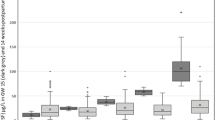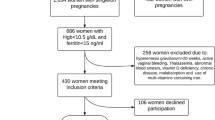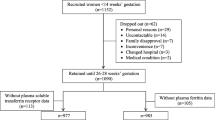Abstract
The review focuses on iron balance during pregnancy and postpartum in the Western affluent societies. Iron status and body iron can be monitored using serum ferritin, haemoglobin, serum soluble transferrin receptors (sTfR) and the sTfR/ferritin ratio. Requirements for absorbed iron increase during pregnancy from 0.8 mg/day in the first trimester to 7.5 mg/day in the third trimester. Average requirement during the entire gestation is ~4.4 mg/day. Intestinal iron absorption increases during pregnancy, but women with ample body iron reserves have lower absorption than those with depleted reserves, so increased absorption is, in part, due to progressive iron depletion. Apparently, women do not change dietary habits when they become pregnant. Non-pregnant Scandinavian women have a median dietary iron intake of ~9 mg/day, i.e. more than 90% of the women have an intake below the recommended ~18 mg/day. Non-pregnant women have a low iron status, 42% have serum ferritin levels ≤30 μg/l, i.e. small or depleted iron reserves and 2–4% have iron deficiency anaemia; only 14–20% have ferritin levels >70 μg/l corresponding to body iron of ≥500 mg. The association between high haemoglobin during gestation and a low birth weight of the newborns is caused by inappropriate haemodilution. In placebo-controlled studies on healthy pregnant women, there is no relationship between the women’s haemoglobin and birth weight of the newborns and no increased frequency of preeclampsia in women taking iron supplements.




Similar content being viewed by others
References
Walters GO, Miller FM, Worwood M (1973) Serum ferritin concentration and iron stores in normal subjects. J Clin Pathol 26:770–772
Milman N (1996) Serum ferritin in Danes: studies of iron status from infancy to old age, during blood donation and pregnancy. Int J Hematol 63:103–135
Milman N, Strandberg NS, Visfeldt J (1983) Serum ferritin in healthy Danes: relation to marrow haemosiderin iron stores. Dan Med Bull 30:115–120
Worwood M (1994) Laboratory determination of iron status. In: Brock JH, Halliday JW, Pippard MJ, Powell LW (eds) Iron metabolism in health and disease. WB Saunders, London, pp 449–476
Baynes RD (1994) Iron deficiency. In: Brock JH, Halliday JW, Pippard MJ, Powell LW (eds) Iron metabolism in health and disease. Saunders, London, pp 204–207
Carriage MT, Skikne S, Finley B, Cutler B, Cook JD (1991) Serum transferrin receptor for the detection of iron deficieny. Am J Clin Nutr 54:107–181
Akesson A, Bjellerup P, Berglund M, Bremme K, Vahter M (1998) Serum transferrin receptor: a specific marker of iron deficiency in pregnancy. Am J Clin Nutr 68:1241–1246
Cook JD, Flowers CH, Skikne BS (2003) The quantitative assessment of body iron. Blood 101:3359–3364
Svanberg B (1975) Absorption of iron in pregnancy. Acta Obstet Gynecol Scand Suppl 48
Bothwell TH (2000) Iron requirements in pregnancy and strategies to meet them. Am J Clin Nutr 72:257S–64S
Hallberg L (1988) Iron balance in pregnancy. In: Berger H (ed) Vitamins and minerals in pregnancy and lactation. Nestlé Nutr Workshop Ser 16:115–127
Saddi R, Shapira G (1970) Iron requirements during growth. In: Hallberg L, Harwerth HG, Vanotti A (eds) Iron deficiency. Academic, London, pp 183–198
Pietrangelo A (2002) Physiology of iron transport and the hemochromatosis gene. Am J Physiol Gastrointest Liver Physiol 282:G403–G414
Heinrich HC, Bartels H, Heinisch B, Hausmann K, Kuse R, Humke W, Mauss HJ (1968) Intestinale 59Fe-Resorption und prälatenter Eisenmangel während der Gravidität des Menschen. Klin Wschr 46:199–202
Barrett FR, Whittaker PG, Williams JG, Lind T (1994) Absorption of non-haem iron from food during normal pregnancy. Br Med J 309:79–82
O’Brien KO, Zavaleta N, Caulfield LE, Yang D-X, Abrams SA (1999) Influence of prenatal iron and zinc supplements on supplemental iron absorption, red blood cell iron incorporation, and iron status in pregnant Peruvian women. Am J Clin Nutr 69:509–515
Trygg K, Lund-Larsen K, Sandstad B, Hoffman HJ, Jacobsen G, Bakketeig LS (1995) Do pregnant smokers eat differently from pregnant non-smokers? Pediatr Perinat Epidemiol 9:307–319
Andersen NL, Fagt S, Groth MV, Hartkopp HB, Møller A, Ovesen L, Warming DL (1995) Dietary habits in Denmark 1995. Main results. National Food Agency of Denmark, Copenhagen, Publication no. 235
Nordic Council of Ministers (2004) Nordic nutrition recommendations 2004. Copenhagen
FAO/WHO Expert Consultation (1988) Requirements of vitamin A, iron, folate and vitamin B12 (Joint report). FAO Food and Nutr Ser 23:33–50
Department of Health. (1991) Dietary reference values for food energy and nutrients for the United Kingdom. Report on health and social subjects. HSMO report no. 41, pp 161–166
Commission of the European Communities (1993) Nutrient and energy intakes for the European community. Reports of the scientific committee for food. Directorate-general industry 31st series: 180–181
Skikne B, Baynes RD (1994) Iron absorption. In: Brock JH, Halliday JW, Pippard MJ, Powell LW (eds) Iron metabolism in health and disease. Saunders, London, pp 151–187
Thomas B (1989) Manual of dietetic practice. Blackwell, London
Milman N, Clausen J, Byg K-E (1998) Iron status in 268 Danish women aged 18–30 years. Influence of menstruation, method of contraception, and iron supplementation. Ann Hematol 76:13–19
Milman N, Byg, K-E, Ovesen L (2000) Iron status in Danes updated 1994. II: Prevalence of iron deficiency and iron overload in 1,319 Danish women aged 40–70 years. Influence of blood donation, alcohol intake, and iron supplementation. Ann Hematol 79:612–621
Pritchard JA, Mason RA (1964) Iron stores of normal adults and replenishment with oral iron therapy. J Am Med Assoc 190:897–901
Milman N, Graudal N, Galløe A, Agger AO (1996) Serum ferritin and selective iron prophylaxis in pregnancy? J Intern Med 240:47–50
Bruner A, Joffe A et al (1996) Randomised study of cognitive effects of iron supplementation in non-anemic iron-deficient adolescent girls. Lancet 348:992–996
Rowland TW, Deisroth MB, Green GM, Kelleher JF (1988) The effect of iron therapy on the exercise capacity of non-anemic iron-deficient adolescent runners. Am J Dis Child 142:165–169
Williams MD, Wheby MS (1992) Anemia in pregnancy. Med Clin North Am 76:631–647
Milman N, Byg K-E, Graudal N, Agger AO (2000) Reference values for hemoglobin and erythrocyte indices during normal pregnancy in 206 women with and without iron supplementation. Acta Obstet Gynecol Scand 78:89–98
Milman N, Agger OA, Nielsen OJ (1991) Iron supplementation during pregnancy. Effect on iron status markers, serum erythropoietin and human placental lactogen. A placebo controlled study in 207 Danish women. Dan Med Bull 38:471–476
Milman N, Bergholt T, Eriksen L, Byg K-E, Graudal N, Pedersen P, Hertz J (2005) Iron prophylaxis during pregnancy—how much iron is needed? A randomised, controlled study of 20 to 80 mg ferrous iron daily to pregnant women. Acta Obstet Gynecol Scand 84:238–247
Thompson WG (1988) Comparison of tests for diagnosis of iron depletion in pregnancy. Am J Obstet Gynecol 5:1132–1134
Van den Broek NR, Letsky EA, White SA, Shenkin A (1998) Iron status in pregnant women: which measurements are valid? Br J Haematol 103:817–824
World Health Organization (1972) Nutritional anaemias. Technical report series no. 503, pp 1–29
Milman N, Graudal N, Nielsen OJ, Agger AO (1997) Serum erythropoietin during normal pregnancy: relationship to hemoglobin and iron status markers and impact of iron supplementation in a longitudinal, placebo-controlled study on 118 women. Int J Hematol 6:159–168
Barton DPJ, Joy M-T, Lappin TRJ et al (1994) Maternal erythropoietin in singleton pregnancies: a randomised trial on the effect of oral hematinic supplementation. Am J Obstet Gynecol 170:896–901
McMullin MF, White R, Lappin T, Reeves J, MacKenzie G (2003) Haemoglobin during pregnancy: relationship to erythropoietin and haematinic status. Eur J Haematol 71:44–50
Puolakka J, Jänne O, Pakarinen A, Järvinen PA, Vihko R (1980) Serum ferritin as a measure of iron stores during and after normal pregnancy with and without iron supplements. Acta Obstet Gynecol Scand 95:43–51(Suppl)
Makrides M, Crowther CA, Gibson RA, Gibson RS, Skeaff CM (2003) Efficacy and tolerability of low-dose iron supplements during pregnancy: a randomised controlled trial. Am J Clin Nutr 78:145–153
Preziosi P, Prual A, Galan P, Daouda H, Boureima H, Hercberg S (1997) Effect of iron supplementation on the iron status of pregnant women: consequences for the newborn. Am J Clin Nutr 66:1178–1182
Zimmerman R, Breymann C, Richter C, Huch R, Huch A (1995) rhEPO treatment of postparum anemia. J Perinat Med 23:111–117
Lebrecht A, Aberlin F, Eberhard J (1995) Anemia in puerperium; parenteral iron substitution renders erythropoietin therapy dispensable. Geburtshilfe Frauenheilkunde 55:167–170
Milman N, Kirchhoff M, Jørgensen T (1992) Iron status markers, serum ferritin and hemoglobin in 1359 Danish women in relation to menstruation, hormonal contraception, parity and postmenopausal hormone treatment. Ann Hematol 65:96–102
Sagen N, Nielsen ST, Kim HC, Bjergsø P, Koller O (1984) Maternal hemoglobin concentration is closely related to birth weight in normal pregnancies. Acta Obstet Gynecol Scand 63:245–248
Steer P, Alam MA, Wadsworth J, Welch A (1995) Relation between maternal haemoglobin concentration and birth weight in different ethnic groups. Br Med J 310:489–491
Murphy JF, Newcombe RG, O’Riordan J, Coles EC, Pearson JF (1986) Relation of haemoglobin levels in the first and second trimesters to outcome of pregnancy. Lancet 1:992–994
Author information
Authors and Affiliations
Corresponding author
Rights and permissions
About this article
Cite this article
Milman, N. Iron and pregnancy—a delicate balance. Ann Hematol 85, 559–565 (2006). https://doi.org/10.1007/s00277-006-0108-2
Received:
Accepted:
Published:
Issue Date:
DOI: https://doi.org/10.1007/s00277-006-0108-2




